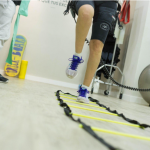Understanding Falls Throughout the Life Cycle: Causes and Prevention
Accidents are the fourth leading cause of death in the United States, and accidental falls make up a decent part of that. Out of all age groups, older adults are most likely to experience a fall, followed by young children. At the beginning of the life cycle, falls are more likely to increase with age (from infancy into early childhood), and then decrease with age. The risk then becomes higher again in late adulthood.
Infancy is typically defined as birth to 12 or 18 months, but usually, before a baby starts walking. Falls in infancy typically happen when the infant can roll over, crawl, or when they’re able to tip over a walker or infant seat. They’re also common when an infant is left unattended on a bed, couch, or changing table. The good news is that babies’ bones are more flexible than adult bones, so they don’t tend to fracture easily. If they do, they heal much faster than adult bones.
The older an infant gets, the more mobile they become and the harder it is to prevent falls— but they can be prevented. Don’t leave infants of any age unattended on beds, couches, or changing tables, and place baby gates at the tops and bottoms of stairs for mobile infants. Also, always strap infants in bouncy seats and car seats and always place these items on the floor, not a counter or table.
Toddlers and young children (aged 18 months to six years) are becoming increasingly mobile and active, so falls are very likely to occur in this stage of life. Within this age group, falls are most likely to occur at home. Toddlers and younger children tend to fall when crawling, walking, or running through the house. Older children also have a natural curiosity and like to climb things.
Older children, aged seven to 11 are more likely to experience falls on playgrounds, rather than around the home. They can either fall from playground equipment or fall while running around on the playground. School-aged children are also likely to fall from bicycles and scooters, so it’s important to make sure they’re wearing a helmet when doing so. The good news is that these accidental falls are, while common, not usually serious.
During adolescence (around age 11 to 18), falls are pretty rare but can happen in a variety of different ways. Younger adolescents may still play on playgrounds and fall from the equipment, while older adolescents are more active and may fall and sustain other injuries while playing sports. Older teens may also fall when engaged in extreme activities such as hiking, but this is also pretty rare.
Falls in adulthood (age 18 and beyond) are most likely due to work environment and premises hazards. Depending on the job industry, some falls may result in more serious injuries than others. For example, adults working in roofing and other construction-related job fields are more likely to experience a fall from a height— which is more likely to be fatal— while adults working in warehouses and other similar environments are likely to fall from a shorter distance, such as off a ladder.
Adults can also experience falls in public places, such as grocery stores, malls, and restaurants— particularly if the floor is slippery or icy. Also, damaged carpets can be tripping hazards, and property owners will be held liable if the results in an injury. Slip and fall lawyers are available to hold these property owners accountable for any injuries their negligence may have caused.
Elder falls refers to the elderly/senior citizen (someone over the age of 65) experiencing a fall. Also known as senior falls, elder falls are more common and also more fatal than any of the other types of falls (outside of construction workers falling from a height), which is why it’s in a separate category from adult falls. Seniors are also more susceptible to falls due to age-related loss of bone density and muscle mass. These falls are most likely to occur in the home or assisted living facility, but they’re also likely to occur in public places— even in the absence of slippery and icy surfaces.
Overall, everyone must be careful to avoid a fall, and it starts by knowing the risk factors related to your age. Parents must understand how to keep their children safe from falls, while adolescents are old enough to understand their own risks, with parental guidance. Elderly individuals may also need some assistance from younger adults. Unfortunately, even with extra precaution, not all falls can be prevented— particularly if another party’s negligent act caused the fall.








